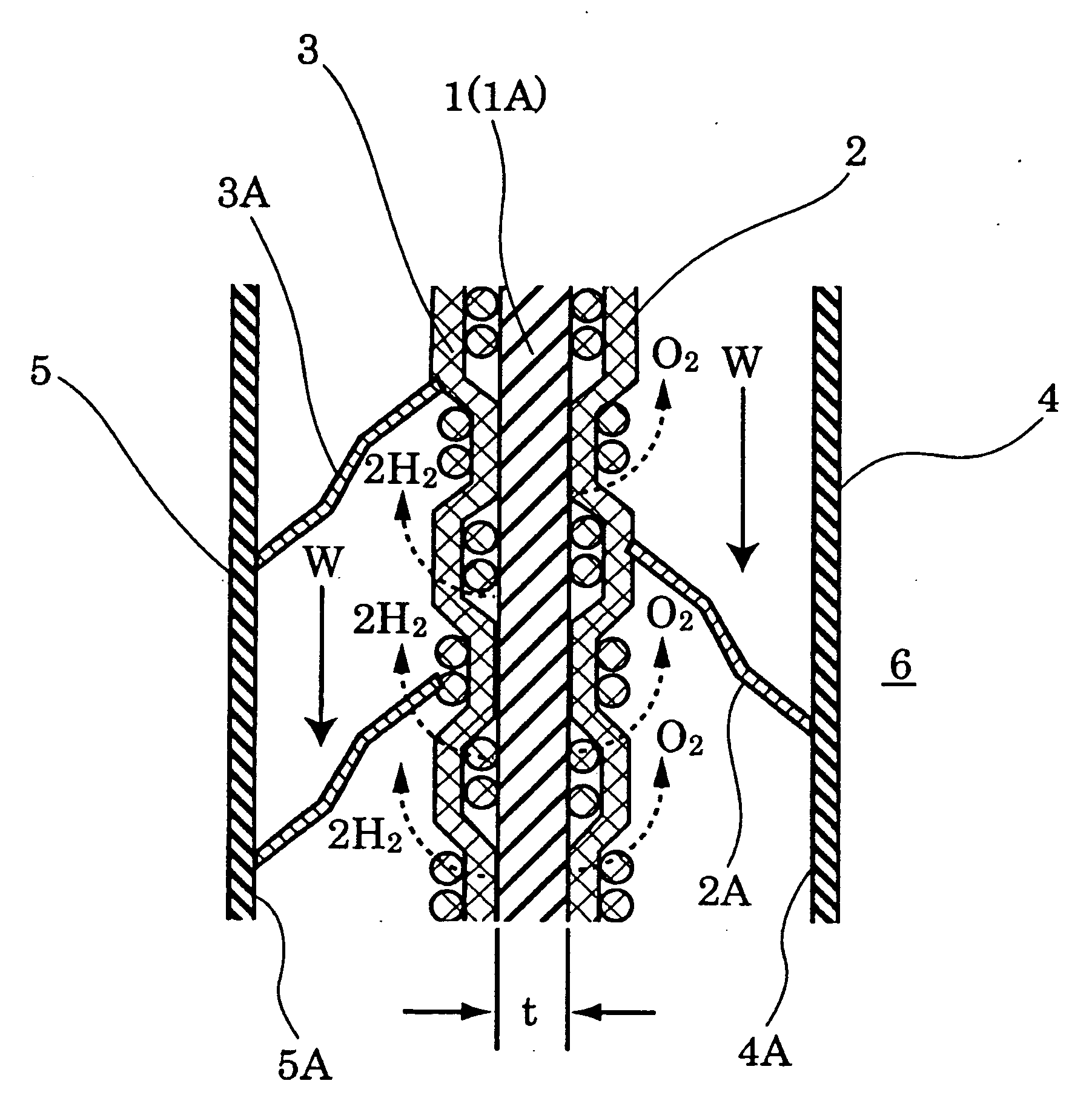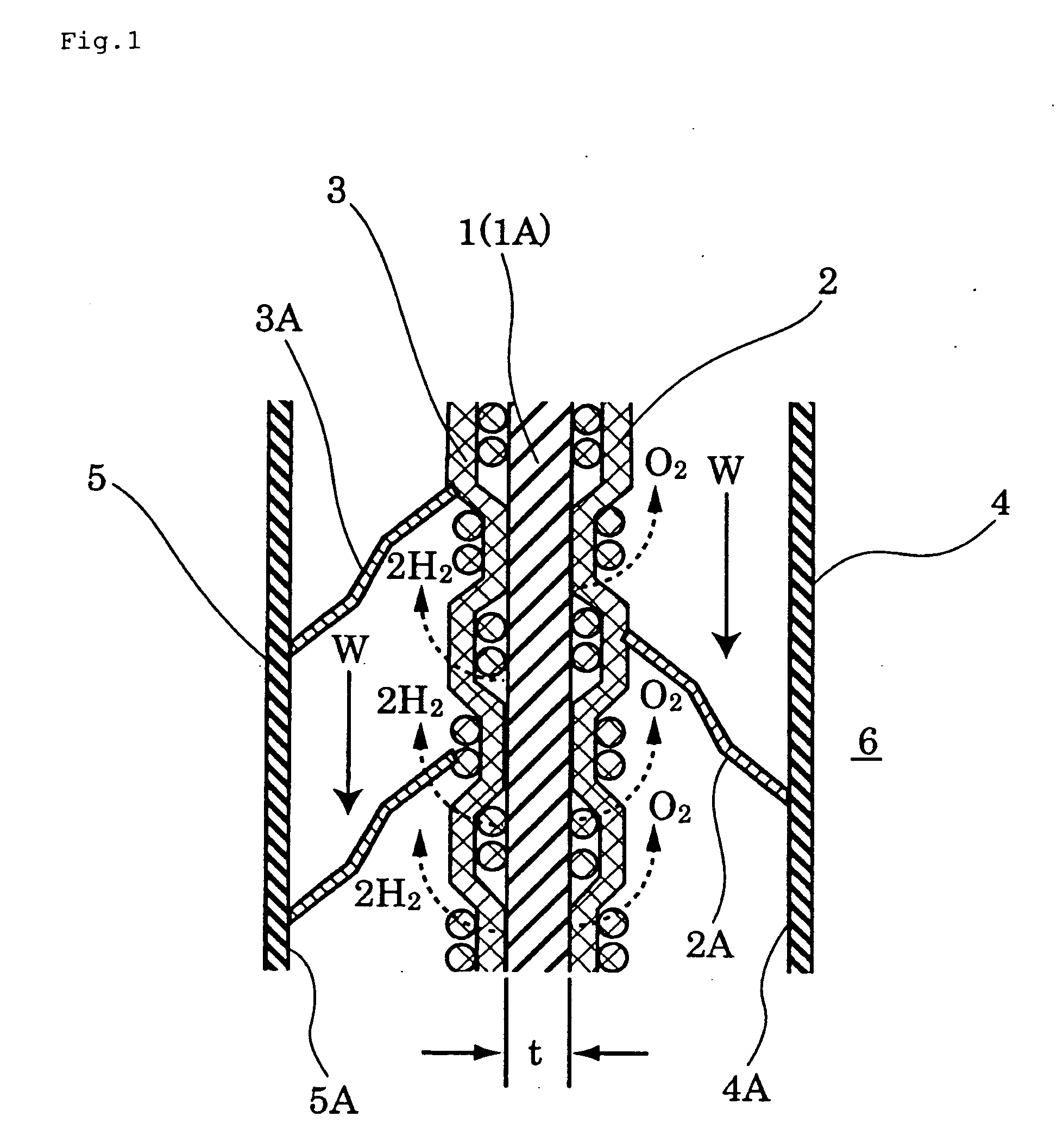Ion-permeable diaphragm
- Summary
- Abstract
- Description
- Claims
- Application Information
AI Technical Summary
Benefits of technology
Problems solved by technology
Method used
Image
Examples
example 1
Manufacture of a Membrane Material Containing Fluoroapatite (FAP)
[0050]A suspension was prepared by mixing 60 wt % (30 g) of N-methyl-2-pyrrolidone (NMP), 32 wt % (16 g) of fluoroapatite (FAP, by Kanto Chemical) having an average particle size of 5 μm, and 8 wt % (4 g) of polysulfone (PSF, trade name UDEL, by Solvay Advanced Polymers), under thorough stirring to dissolve the polysulfone (PSF) and disperse the FAP.
[0051]Then, 10 mL of the resulting suspension were poured onto a 10 cm×10 cm glass frame over which there was stretched a 200-mesh polypropylene woven fabric (fiber diameter: 87 μm, trade name Nippu (polypropylene) strong mesh, by NBC) at a position 400 μm from the bottom, to prepare thereby a wet sheet having a surface area of 100 cm2 and a thickness of about 500 μm.
[0052]Immediately after pouring the suspension, the frame was moved into a water bath, where it was left to stand for 5 minutes at room temperature, to leach the N-methyl-2-pyrrolidone (NMP) solvent out of the ...
example 2
Manufacture of a Membrane Material Containing Hydroxyapatite (HAP)
[0053]A suspension was prepared by mixing 65 wt % (30 g) of N-methyl-2-pyrrolidone (NMP), 26 wt % (12 g) of hydroxyapatite (HAP, by Kishida Chemical) having an average particle size of 5 μm, and 9 wt % (4 g) of polysulfone (PSF, trade name UDEL, by Solvay Advanced Polymers), under thorough stirring to dissolve the polysulfone (PSF) and disperse the hydroxyapatite (HAP).
[0054]A sheet-like membrane material having a thickness of about 400 μm was manufactured out of the resulting suspension in the same way as in Example 1.
example 3
Manufacture of a Membrane Material Containing Calcium Fluoride (CaF2)
[0055]A suspension was prepared by mixing 65 wt % (30 g) of N-methyl-2-pyrrolidone (NMP), 26 wt % (12 g) of calcium fluoride (CaF2, by Kishida Chemical) having an average particle size of 5 μm, and 9 wt % (4 g) of polysulfone (PSF, trade name UDEL, by Solvay Advanced Polymers), under thorough stirring to dissolve the polysulfone (PSF) and disperse the calcium fluoride (CaF2).
[0056]A sheet-like membrane material having a thickness of about 400 μm was manufactured out of the resulting suspension in the same way as in Example 1.
PUM
| Property | Measurement | Unit |
|---|---|---|
| Thickness | aaaaa | aaaaa |
| Volume | aaaaa | aaaaa |
| Volume | aaaaa | aaaaa |
Abstract
Description
Claims
Application Information
 Login to View More
Login to View More - R&D
- Intellectual Property
- Life Sciences
- Materials
- Tech Scout
- Unparalleled Data Quality
- Higher Quality Content
- 60% Fewer Hallucinations
Browse by: Latest US Patents, China's latest patents, Technical Efficacy Thesaurus, Application Domain, Technology Topic, Popular Technical Reports.
© 2025 PatSnap. All rights reserved.Legal|Privacy policy|Modern Slavery Act Transparency Statement|Sitemap|About US| Contact US: help@patsnap.com


